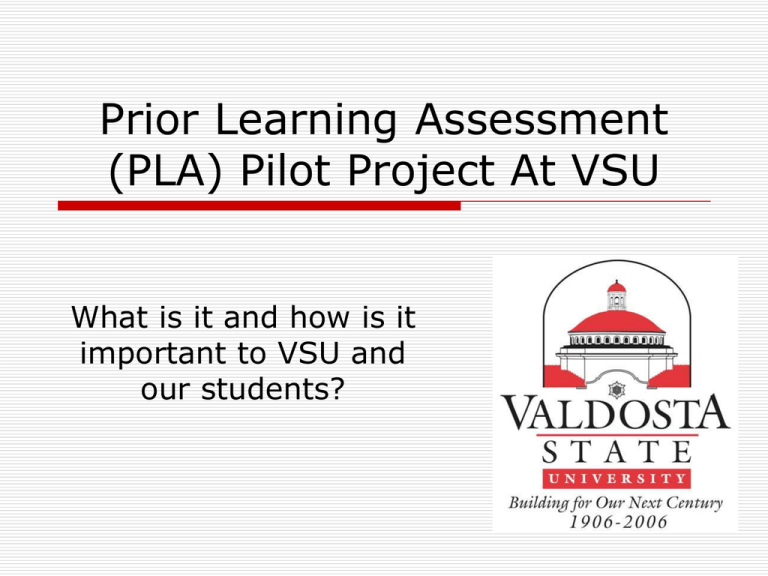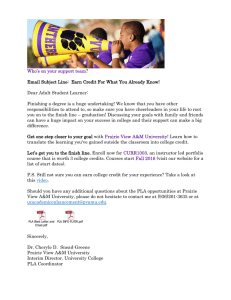Prior Learning Assessment (PLA) Pilot Project At VSU important to VSU and
advertisement

Prior Learning Assessment (PLA) Pilot Project At VSU What is it and how is it important to VSU and our students? Have you had the experience… You find that a student in a class you are teaching: Already has the knowledge, skills, or abilities that will be taught in the course. Does not need to be in the class. We have not had a way to recognize the student’s knowledge or the learning that took place before the student signed up for that course. What if… the student got help preparing documentation and submitted it to faculty? 2 This is the concept behind Prior Learning Assessment (PLA) The real focus of PLA is on assessment methods that fit traditional learning experiential learning Courses Training Programs (e.g. military) Work Experience Community Service Personal Study CLEP (The College-Level Examination Program®) AP (Advanced Placement) Departmental Examinations A way to recognize the learning a student brings to the university from other settings With faculty and department determining the credit PLA fits with existing methods for granting credit: 3 PLA Pilot Project at VSU Current PLA pilot project under way, supported by University System of Georgia Faculty will serve as assessors to: determine the appropriateness of a student’s knowledge and the possible match with course outcomes The pilot project will help us develop guidelines for how best to proceed with implementation of PLA. 4 Basis of PLA Assessment Assessment focuses Learning on learning – not just experience Learning is based on experience and academic theory Experience + Theory 5 Faculty Role & Compensation A professor who is a subject matter expert is recruited to develop a method of assessment based on the outcomes for the relevant course. The professor will evaluate the documentation provided by the student. The results of the PLA Pilot project will be used to determine the amount of time required to develop the assessments and appropriate compensation for the faculty. 6 Student Role Students provide documentation for the learning and must convince assessors that: experiences are relevant and appropriate to the course subject learning from those experiences is substantive learning is aligned with course outcomes learning is grounded on relevant theory. Students will receive guidance on the preparation of the documentation and it will be reviewed before it is submitted 7 to faculty for final consideration. Criteria for Quality Assurance in Assessing Learning for Credit The Council for Adult and Experiential Learning (CAEL) has spent over 30 years establishing and promoting quality standards among institutions of higher learning: Credit or its equivalent will be awarded only for learning, and not for experience. Assessment should be based on standards and criteria for the level of acceptable learning. Assessment should be treated as an integral part of learning, not separate from it, and should be based on an understanding of learning processes. The determination of credit awards and competence levels must be made by appropriate subject matter and academic or credentialing experts. Credit or other credentialing will be appropriate to the academic context in which it is awarded and accepted. The program of study and the student’s major, i.e., core, upperdivision, or graduate, of the student determines the “academic context.” Adapted From: Morry Fiddler, Catherine Marieneau & Urban Whitaker. Assessing Learning: Standards, Principles, & Procedures. Chicago: CAEL (Council for Adult and Experiential Learning), 2006. For more information visit: The Council for Adult and Experiential Learning (CAEL) at http://www.cael.org/. 8 Why are we talking about Prior Learning Assessment (PLA) ? The PLA Pilot Project was initiated by the University System of Georgia with the initial goal of helping to address the shortage of teachers. Career-changers are a rich source of teachers. More than 40% of students nationally are selfsupporting adults age 24 or older. This population brings potentially creditable experience that can accelerate time to graduation. PLA provides a way to build on workers’ skills and increase transferability. The project has now been extended to cover students in majors or career fields other than Education. 9 Why is the PLA Pilot Project being conducted at VSU? PLA Project fits with goals and strategic plans of both USG and VSU See VSU’s Strategic Planning Goals: 5 Goals in 5 Years Develop a proposal for programs and program delivery strategies that meet the needs of non-traditional degree seeking students. Move to Outcomes-Based Teaching fits with SACS requirements. PLA Pilot Project supported by Grant resources from US Department of Education. The PLA model developed at VSU will be extended to other USG units. 10 In Summary PLA is important to students Faculty and departments will determine credit Pilot project is under way at VSU Processes are based on CAEL practices and quality assurance standards 11


